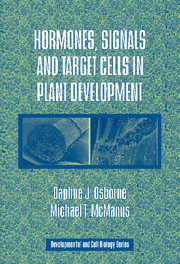Book contents
- Frontmatter
- Contents
- Preface
- 1 Introduction
- 2 Hormones and Signals: Identification and Description of Signalling Molecules
- 3 Cell-to-Cell Signalling: Short and Long Distance
- 4 Population Diversity of Cell Types and Target Identification in Higher Plants
- 5 Flexibility of Cell Types and the Target Cell Status
- 6 Terminally Committed Cell Types and the Target Status
- 7 The Mechanisms of Target Cell Perception and Response to Specific Signals
- 8 Hormone Action and the Relief of Repression
- 9 The Phenomenon of Hormonal Cross-Talk
- References
- Index
Preface
Published online by Cambridge University Press: 06 August 2009
- Frontmatter
- Contents
- Preface
- 1 Introduction
- 2 Hormones and Signals: Identification and Description of Signalling Molecules
- 3 Cell-to-Cell Signalling: Short and Long Distance
- 4 Population Diversity of Cell Types and Target Identification in Higher Plants
- 5 Flexibility of Cell Types and the Target Cell Status
- 6 Terminally Committed Cell Types and the Target Status
- 7 The Mechanisms of Target Cell Perception and Response to Specific Signals
- 8 Hormone Action and the Relief of Repression
- 9 The Phenomenon of Hormonal Cross-Talk
- References
- Index
Summary
This volume presents a conceptual approach to plant cell differentiation that differs in a number of respects from those already present in the literature. We seek to show how every cell has an individual competence to respond to the signal inputs that may impinge upon it and how every cell then has an individual qualitative and quantitative response. Central to this target cell concept is the premise that each cell is selective and can therefore discriminate amongst the many incoming signals to which it is exposed by an ability to perceive them and to respond to them.
Because each cell occupies its individual position within the plant body, the intensity or diversity of the signal inputs that it receives are not themselves identical. Hence, each cell is a unique individual and displays a unique target status even though it may also possess considerable commonality with its neighbours. We define this target status of a cell as the selectivity of its response to a signal and the intensity of that response.
The target cell concept arose originally from notions that were current amongst insect and mammalian scientists stating that a regulatory chemical produced in one organ would be perceived and activated upon by the cells in a distant organ – a specificity that operated between two distinct cell types. As the evidence for specificity of response to hormonal inputs increased during the twentieth century, developmental biologists saw this ability of cells to discriminate amongst the multitude of chemical signals to which they were exposed as a marker of the cell's ability to discriminate between them.
- Type
- Chapter
- Information
- Hormones, Signals and Target Cells in Plant Development , pp. xi - xiiPublisher: Cambridge University PressPrint publication year: 2005



